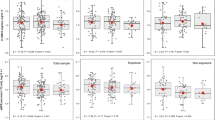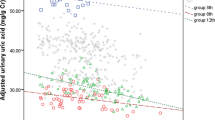Abstract
Interindividual genetic variations determine human’s susceptibility to heavy metal-induced toxicity. Thus, we analyzed blood concentrations of lead (Pb) and cadmium (Cd) in 140 lead-exposed children. Genotyping of the glutathione S-transferase (GST) genes, GSTM1, GSTT1, and GSTP1 genes, was carried out to investigate their possible association with heavy metal concentrations and the risk of susceptibility to Pb toxicity. Exposure to both heavy metals was prevalent among the children. The blood Pb level ranged from 3.30 to 74.0 μg dL-1 with an average value of 26.8 μg dL-1 that is five times above its reference level. The average Cd level (0.22 μg L-1) was below its reference level. The metal-gene interaction showed positive correlation between GSTT1 null genotype and Pb and Cd levels (β = 0.11; p = 0.02 and β = 0.10; p = 0.01, respectively). More pronounced effects (β = 0.19; p < 0.01 and β = 0.25; p = 0.04) were found for the mixture of the three putative genes with blood Pb concentration. The susceptibility analysis using 10 μg dL-1 as blood Pb cutoff level showed a high risk of Pb toxicity (OR = 2.54; 95% CI: 1.02-6.32, p = 0.04) for children carrying the GSTP1 Ile/Val genotype. Further, the combined effect of GSTP1 Ile/Val with GSTT1 null genotype was more pronounced and showed an increased risk of susceptibility to Pb toxicity (OR = 11.7; 95% CI: 1.36-102.1, p = 0.02). In summary, this study suggests that GSTT1 null and GSTP1 Ile/Val genotypes are the main genetic factors, and individual and specific combinations of GSTP1 Ile/Val with GSTM1 and GSTT1 GST polymorphisms are associated with susceptibility to Pb toxicity.



Similar content being viewed by others
Data availability
Not applicable.
References
Amrhein V, Greenland S, McShane B (2019) Scientists rise up against statistical significance. Nature 567:305–307. https://doi.org/10.1038/d41586-019-00857-9
Centers for Disease Control and Prevention (CDC) (2012) Update on BLLs in children. Available online at http://www.cdc.gov/nceh/lead/ACCLPP/blood_lead_levels.htm. Accessed 1 June 2020
Eum KD, Wang FT, Schwartz J, Hersh CP, Kelsey K, Wright RO, Spiro A, Sparrow D, Hu H, Weisskopf MG (2013) Modifying roles of glutathione S-transferase polymorphisms on the association between cumulative lead exposure and cognitive function. Neurotoxicology 39:65–71. https://doi.org/10.1016/j.neuro.2013.08.002
Eum KD, Seal RM, Taylor KM, Grespin M, Umbach DM, Hu H, Sandler DP, Kamel F, Weisskopf MG (2015) Modification of the association between lead exposure and amyotrophic lateral sclerosis by iron and oxidative stress related gene polymorphisms. Amyotroph Lateral Scler Frontotemporal Degener 16(1-2):72–79. https://doi.org/10.3109/21678421.2014.964259
Godwill EA, Ferdinand PU, Nwalo FN, Unachukwu MN (2019) Mechanism and health effects of heavy metal toxicity in humans. In: Poisoning in the modern world - new tricks for an old dog? Intechopen. https://doi.org/10.5772/intechopen.82511
Hayes JD, Flanagan JU, Jowsey IR (2005) Glutathione transferases. Annu Rev Pharmacol Toxicol 45:51–88. https://doi.org/10.1146/annurev.pharmtox.45.120403.095857
Hays SM, Nordberg M, Yager JW, Aylward LL (2008) Biomonitoring equivalents (BE) dossier for cadmium (Cd) (CAS No. 7440-43-9). Regul Toxicol Pharmacol 51(3):S49–S56. https://doi.org/10.1016/j.yrtph.2008.05.008
Hollman AL, Tchounwou PB, Huang HC (2016) The association between gene-environment interactions and diseases involving the human GST superfamily with SNP variants. Int J Environ Res Public Health 13(4):379. https://doi.org/10.3390/ijerph13040379
Hunaiti AA, Soud M (2000) Effect of lead concentration on the level of glutathione, glutathione S-transferase, reductase and peroxidase in human blood. Sci Total Environ 248:45–50. https://doi.org/10.1016/s0048-9697(99)00548-3
International Agency for Research on Cancer (IARC) (2021) IARC monographs on the identification of carcinogenic hazards to humans. List of classifications. Agents classified by the IARC Monographs, 1–129. https://monographs.iarc.who.int/list-of-classifications. Accessed 20 March 2021
Jaishankar M, Tseten T, Anbalagan N, Mathew BB, Berregowda NK (2014) Toxicity, mechanism and health effects of some heavy metals. Interdiscip Toxicol 7(2):60–72. https://doi.org/10.2478/intox-2014-0009
Jan AT, Azam M, Siddiqui K, Ali A, Choi I, Rizwanul Haq QM (2015) Heavy metals and human health: mechanistic insight into toxicity and counter defense system of antioxidants. Int J Mol Sci 16(12):29592–29630. https://doi.org/10.3390/ijms161226183
Jozefczak M, Remans T, Vangronsveld J, Cuypers A (2012) Glutathione is a key player in metal-induced oxidative stress defenses. Int J Mol Sci 13(3):3145–3175. https://doi.org/10.3390/ijms13033145
Kasperczyk S, Kasperczyk A, Ostalowska A, Dziwisz M, Birkner E (2004) Activity of glutathione peroxidase, glutathione reductase, and lipid peroxidation in erythrocytes in workers exposed to lead. Biol Trace Elem Res 102:61–72. https://doi.org/10.1385/bter:102:1-3:061
Khansakorn N, Wongwit W, Tharnpoophasiam P, Hengprasith B, Suwannathon L, Pethchpoung K, Yoovathaworn K, Chanprasertyothin S, Sura T, Kaojarern S, Sritara P, Sirivarasai J (2011) Impact of GSTM1, GSTT1, GSTP1 polymorphism and environmental lead exposure on oxidative stress biomarkers. Sci Res Essays 6(31):6540–6547. https://doi.org/10.5897/SRE11.1519
Khansakorn N, Wongwit W, Tharnpoophasiam P, Hengprasith B, Suwannathon L, Chanprasertyothin S, Sura T, Kaojarern S, Sritara P, Sirivarasai J (2012) Genetic variations of glutathione S-transferase influence on blood cadmium concentration. J Toxicol 2012:356126–356126. https://doi.org/10.1155/2012/356126
Lamichhane DK, Leem JH, Park CS, Ha M, Ha EH, Kim HC, Lee JY, Ko JK, Kim Y, Hong YC (2018) Associations between prenatal lead exposure and birth outcomes: modification by sex and GSTM1/GSTT1 polymorphism. Sci Total Environ 619–620:176–184. https://doi.org/10.1016/j.scitotenv.2017.09.159
Lee BK, Lee SJ, Joo JS, Cho KS, Kim NS, Kim HJ (2012) Association of glutathione S-transferase genes (GSTM1 and GSTT1) polymorphisms with hypertension in lead-exposed workers. Mol Cell Toxicol 8:203–208. https://doi.org/10.1007/s13273-012-0025-5
Palma-Cano LE, Córdova EJ, Orozco L, Martinez-Hernandez A, Cid M, Leal-Berumen I, Licón-Trillo A, Lechuga-Valles R, González-Ponce M, González-Rodríguez E, Moreno-Brito V (2017) GSTT1 and GSTM1 null variants in Mestizo and Amerindian populations from northwestern Mexico and a literature review. Genet Mol Biol 40(4):727–735. https://doi.org/10.1590/1678-4685-GMB-2016-0142
Poddalgoda D, Macey K, Hancock S (2019) Derivation of biomonitoring equivalents (BE values) for zinc. Regul Toxicol Pharmacol 106:178–176. https://doi.org/10.1016/j.yrtph.2019.04.018
Saitou M, Ishida T (2015) Distributions of the GSTM1 and GSTT1 null genotypes worldwide are characterized by latitudinal clines. Asian Pac J Cancer Prev 16:355–361. https://doi.org/10.7314/apjcp.2015.16.1.355
Sanders T, Liu Y, Buchner V, Tchounwou PB (2009) Neurotoxic effects and biomarkers of lead exposure-Review. Rev Environ Health 24(1):15–45. https://doi.org/10.1515/reveh.2009.24.1.15
Sharma A, Pandey A, Sharma S, Chatterjee I, Mehrotra R, Sehgal A, Sharma JK (2014) Genetic polymorphism of glutathione S-transferase P1 (GSTP1) in Delhi population and comparison with other global populations. Meta Gene 2:134–142. https://doi.org/10.1016/j.mgene.2013.12.003
Sirivarasai J, Wananukul W, Kaojarern S, Chanprasertyothin S, Thongmung N, Ratanachaiwong W, Sura T, Sritara P (2013) Association between inflammatory marker, environmental lead exposure, and glutathione S-transferase gene. Biomed Res Int 2013:474963–474966. https://doi.org/10.1155/2013/474963
Tchounwou PB, Yedjou CG, Patlolla AK, Sutton DJ (2012) Heavy metals toxicity and the environment. EXS 101:133–164. https://doi.org/10.1007/978-3-7643-8340-4_6
Yabe J, Nakayama SMM, Nakata H, Toyomaki H, Yohannes YB, Muzandu M, Kataba A, Zyambo G, Hiwatari M, Narita D, Yamada D, Hangoma P, Munyinda NS, Mufune T, Ikenaka Y, Choongo K, Ishizuka M (2020) Current trends of blood lead levels, distribution patterns and exposure variations among household members in Kabwe, Zambia. Chemosphere 243:125412. https://doi.org/10.1016/j.chemosphere.2019.125412
Yamada D, Hiwatari M, Hangoma P, Narita D, Mphuka C, Chitah B, Yabe J, Nakayama SMM, Nakata H, Choongo K, Ishizuka M (2020) Assessing the population-wide exposure to lead pollution in Kabwe, Zambia: an econometric estimation based on survey data. Sci Rep 10:15092. https://doi.org/10.1038/s41598-020-71998-5
Yohannes YB, Yoshinori Y, Nakayama SMM, Mizukawa H, Ishizuka M (2017) Trace element contamination in tissues of four bird species from the Rift Valley Region, Ethiopia. Bull Environ Contam Toxicol 98:172–177. https://doi.org/10.1007/s00128-016-2011-4
Yohannes YB, Nakayama SMM, Yabe J, Nakata H, Toyomaki H, Kataba A, Muzandu K, Ikenaka Y, Choongo K, Ishizuka M (2020) Blead lead levels and aberrant DNA methylation of the ALAD and p16 gene promoters in children exposed to environmental-lead. Environ Res 188:109759. https://doi.org/10.1016/j.envres.2020.109759
Yohannes YB, Nakayama SMM, Yabe J, Toyomaki H, Kataba A, Nakata H, Muzandu K, Ikenaka Y, Choongo K, Ishizuka M (2021) Delta-aminolevulinic acid dehydratase (ALAD) and vitamin D receptor (VDR) genes polymorphisms in children residing in an abandoned lead-zinc mine area in Kabwe, Zambia. Meta Gene 27:100838. https://doi.org/10.1016/j.mgene.2020.100838
Acknowledgements
We are very grateful to the children that participated in this study and the laboratory technicians and nurses at the five health centers in Kabwe. We are also grateful to the Kabwe District Health Office, Kabwe Municipal Council and the Ministry of Health, Zambia, for facilitating our work. Our appreciation is extended to Takahiro Ichise and Nagisa Hirano for their technical support.
Funding
This work was supported by the Grants-in-Aid for Scientific Research from the Ministry of Education, Culture, Sports, Science and Technology of Japan awarded to M. Ishizuka (Nos. 16H0177906, 18K1984708, 18KK028708, 21H02351), Ikenaka (18H0413208), and S.M.M. Nakayama (Nos. 17KK0009 and 20K20633). This work was also supported by the foundation of JSPS Bilateral Open Partnership Joint Research Projects (JPJSBP120209902; SMMN). This work was also supported by JSPS CORE to CORE program (MI), The Japan Prize Foundation; Hokkaido University’s SOUSEI Support Program for Young Researchers in FY2020 (SMMN); and Hokkaido University Specific Research Projects (MI). This research was also supported by JST/JICA, SATREPS (Science and Technology Research Partnership for Sustainable Development; No. JPMJSA1501) and aXis (Accelerating Social Implementation for SDGs Achievement; No. JPMJAS2001) funded by JST as well as Program for supporting introduction of the new sharing system (JPMXS0420100619).
Author information
Authors and Affiliations
Contributions
YBY: Responsible for conceptualization, data analysis, investigation, methodology, and writing both drafting the original paper and reviewing.
SMMN: Responsible for conceptualization, analysis, funding acquisition, investigation, and writing and corresponding author.
JY, HN, HT, AK and KM: Participate in sample collection, material preparation, and reviewing the manuscript.
YK: Funding acquisition and supervision.
KC: Supervision.
MI: Responsible for project administration, funding acquisition, supervision, and reviewing the manuscript and corresponding author.
Corresponding authors
Ethics declarations
Ethics approval
Study protocol approval and permission to conduct the research were obtained from the University of Zambia Research Ethics Committee (UNZAREC; REF. No. 012-04-16) and the Ministry of Health Zambia, respectively. Material transfer agreement (MTA, Approval No. E00417) has been issued from the Ministry of Health, Zambia, for transporting frozen samples to Japan.
Consent to participate
Participation in this study was voluntary, and participants enrolled after getting signed informed consent from the parents.
Consent for publication
Children’s parent signed informed consent before participation and be aware regarding publishing the data. All the coauthors have read the manuscript and agreed for publication.
Competing interests
The authors declare no competing interests.
Additional information
Responsible Editor: Lotfi Aleya
Publisher’s note
Springer Nature remains neutral with regard to jurisdictional claims in published maps and institutional affiliations.
Rights and permissions
About this article
Cite this article
Yohannes, Y.B., Nakayama, S.M.M., Yabe, J. et al. Glutathione S-transferase gene polymorphisms in association with susceptibility to lead toxicity in lead- and cadmium-exposed children near an abandoned lead-zinc mining area in Kabwe, Zambia. Environ Sci Pollut Res 29, 6622–6632 (2022). https://doi.org/10.1007/s11356-021-16098-1
Received:
Accepted:
Published:
Issue Date:
DOI: https://doi.org/10.1007/s11356-021-16098-1




